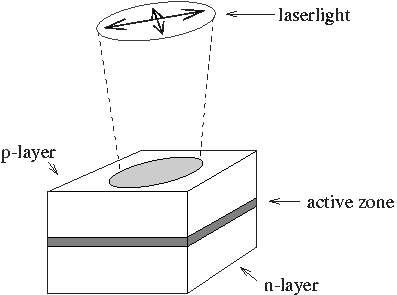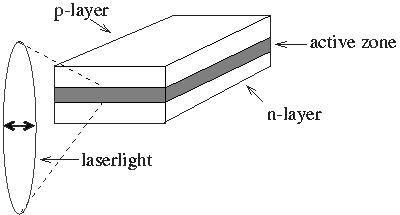Spatio-temporal structures and polarization dynamics in vertical-cavity
surface-emitting lasers
Introduction
Semiconductor laser diodes are ubiqitious in nowadays
scientific and commercial applications such as high-speed data transmission, laser pumping and spectroscopy as well as in everyday life (CD-players, laser printers). Nevertheless - due to the high complexity
of the nonlinear processes in the semiconductor itself as well as in the light-matter interaction - the understanding of many dynamical phenomena in semiconductor laser devices
is far from complete.
Vertical-cavity surface-emitting lasers (VCSELs) are a rather new type of semiconductor laser diode, in which - in contrast to conventionel edge emitters – the direction of the light emission is parallel
to the epitaxial growth direction. The advantageous properties of this design resulted in a large interest in applied as well as in pure research. In particular, one can achieve single-longitudinal mode emission due to
a short cavity length, a low threshold current density and a rotationally symmetric shape of the active zone, which in turn implies the possibility of a circular emission profile. The latter is very important in many applications,
e.g. in fiber coupling, and therefore VCSELs are superior light sources for communication in local-area-networks (LAN).
However, the very same design properties, which make VCSELs so interesting for applications, imply also a high vulnerability to instabilities. In particular, the high degree of symmetry and the potentially large transverse extent of the active zone implies that a lot of degrees of freedom can be excited which differ in their spatial
structure and/or in their polarization properties. These instabilities limit the power and/or the coherence of the emitted laser beam. On the other hand, it opens the possibility to investigate a rich spectrum of self-organization phenomena in lasers in a quasi two-dimensional situation and with a rather high aspect ratio. Due to the characteristics of the dielectric susceptibility of semiconductor lasers one has also to be
aware of the possibility of temporal dynamics on very different time scales, including very short ones (ps).
Thus, VCSELS are a technologically relevant system with complex nonlinearities in which basic properties are determined by self-organization phenomena in space, time and polarization. A thorough understanding of these phenomena is expected to help in improving commercial systems in the long run. Therefore, an important aim of the research is the development of control schemes. The control of spatio-temporal structures is also one of the important and unsolved problems in fundamental research on spontaneous pattern formation.
 |

|
|
Scheme of a VCSEL
|
Scheme of an edge emitting laser
|
Projects
Team Members
|

